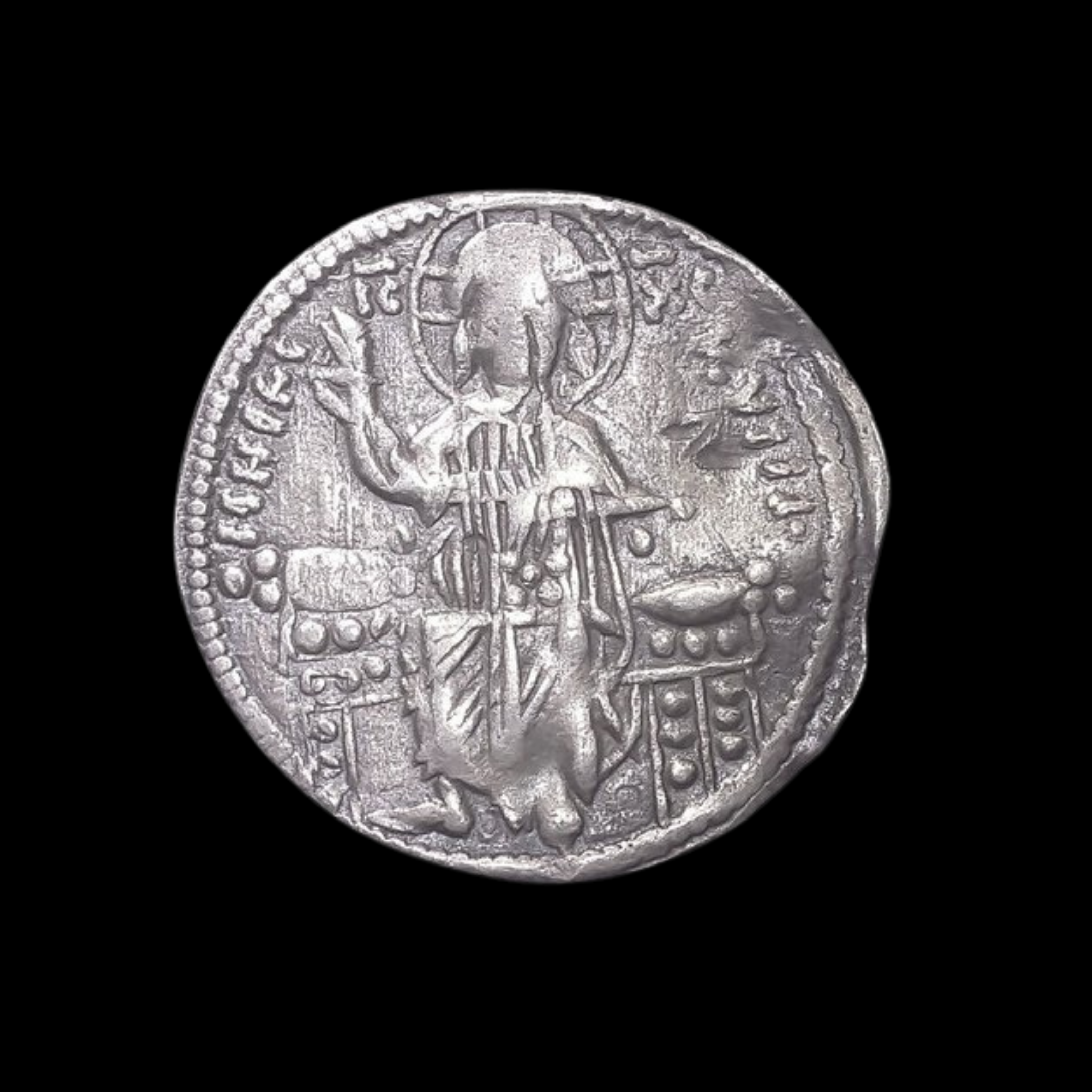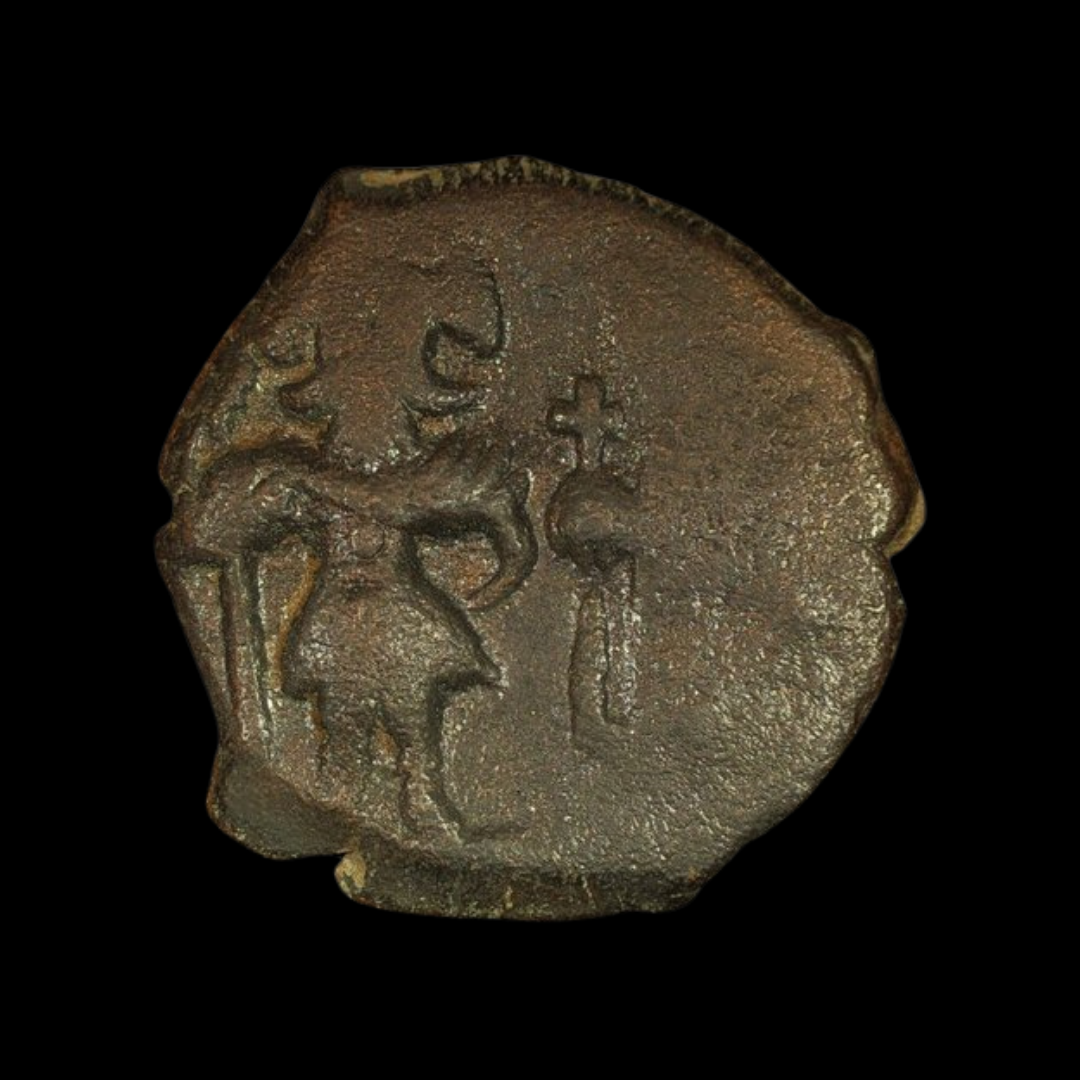 Image 1 of 2
Image 1 of 2

 Image 2 of 2
Image 2 of 2



Silver Miliaresion of Basil I and Constantine (1,150 years ago)
This silver coin was minted in Constantinople (modern-day Istanbul, Turkey) between 868-879 AD during the joint reign of Byzantine Emperor Basil I and his son Constantine. It represents an important Byzantine silver denomination used for larger transactions.
Coin Description:
Front side: Potent cross (cross with crossbars at the end of each arm) placed on three levels above a small globe, surrounded by a double circular border and the Greek inscription "IHSYS XRISTYS NICA" meaning "Jesus Christ Victorious."
Back side: Six-line Greek inscription within a double circular border reading "BASILIOS CE CONSTANTIN PISTV BASILIS ROMEO" meaning "Basil and Constantine faithful kings of the Romans."
Technical Details:
Material: Pure silver (1000‰ fineness)
Denomination: Miliaresion (major silver coin worth 1/12 of a gold solidus)
Size: 24mm diameter
Weight: 3.33 grams
Die orientation: 1h (die axis at 1 o'clock position)
Period: 868-879 AD
Mint: Constantinople
Condition: Well-centered, slightly veiled, superb reverse strike, gray patina
Catalog References: BMC/B.6, R.1860, Do.7, BN/B.1, BC.1708, DMBR.33/4
Historical Significance:
This coin was issued during a period of consolidation for the Byzantine Empire under Basil I, who founded the Macedonian dynasty that would rule for nearly two centuries. The loss of Syracuse to Islamic forces in 878 AD marked the permanent loss of Sicily during this reign, but Basil focused on internal reforms including legal codification known as the Basilica. The explicitly Christian inscriptions and imagery demonstrate the central role of Orthodox Christianity in Byzantine imperial ideology, while the continued production of high-quality silver coinage reflects the empire's economic resilience despite territorial losses in the western Mediterranean.
This silver coin was minted in Constantinople (modern-day Istanbul, Turkey) between 868-879 AD during the joint reign of Byzantine Emperor Basil I and his son Constantine. It represents an important Byzantine silver denomination used for larger transactions.
Coin Description:
Front side: Potent cross (cross with crossbars at the end of each arm) placed on three levels above a small globe, surrounded by a double circular border and the Greek inscription "IHSYS XRISTYS NICA" meaning "Jesus Christ Victorious."
Back side: Six-line Greek inscription within a double circular border reading "BASILIOS CE CONSTANTIN PISTV BASILIS ROMEO" meaning "Basil and Constantine faithful kings of the Romans."
Technical Details:
Material: Pure silver (1000‰ fineness)
Denomination: Miliaresion (major silver coin worth 1/12 of a gold solidus)
Size: 24mm diameter
Weight: 3.33 grams
Die orientation: 1h (die axis at 1 o'clock position)
Period: 868-879 AD
Mint: Constantinople
Condition: Well-centered, slightly veiled, superb reverse strike, gray patina
Catalog References: BMC/B.6, R.1860, Do.7, BN/B.1, BC.1708, DMBR.33/4
Historical Significance:
This coin was issued during a period of consolidation for the Byzantine Empire under Basil I, who founded the Macedonian dynasty that would rule for nearly two centuries. The loss of Syracuse to Islamic forces in 878 AD marked the permanent loss of Sicily during this reign, but Basil focused on internal reforms including legal codification known as the Basilica. The explicitly Christian inscriptions and imagery demonstrate the central role of Orthodox Christianity in Byzantine imperial ideology, while the continued production of high-quality silver coinage reflects the empire's economic resilience despite territorial losses in the western Mediterranean.
This silver coin was minted in Constantinople (modern-day Istanbul, Turkey) between 868-879 AD during the joint reign of Byzantine Emperor Basil I and his son Constantine. It represents an important Byzantine silver denomination used for larger transactions.
Coin Description:
Front side: Potent cross (cross with crossbars at the end of each arm) placed on three levels above a small globe, surrounded by a double circular border and the Greek inscription "IHSYS XRISTYS NICA" meaning "Jesus Christ Victorious."
Back side: Six-line Greek inscription within a double circular border reading "BASILIOS CE CONSTANTIN PISTV BASILIS ROMEO" meaning "Basil and Constantine faithful kings of the Romans."
Technical Details:
Material: Pure silver (1000‰ fineness)
Denomination: Miliaresion (major silver coin worth 1/12 of a gold solidus)
Size: 24mm diameter
Weight: 3.33 grams
Die orientation: 1h (die axis at 1 o'clock position)
Period: 868-879 AD
Mint: Constantinople
Condition: Well-centered, slightly veiled, superb reverse strike, gray patina
Catalog References: BMC/B.6, R.1860, Do.7, BN/B.1, BC.1708, DMBR.33/4
Historical Significance:
This coin was issued during a period of consolidation for the Byzantine Empire under Basil I, who founded the Macedonian dynasty that would rule for nearly two centuries. The loss of Syracuse to Islamic forces in 878 AD marked the permanent loss of Sicily during this reign, but Basil focused on internal reforms including legal codification known as the Basilica. The explicitly Christian inscriptions and imagery demonstrate the central role of Orthodox Christianity in Byzantine imperial ideology, while the continued production of high-quality silver coinage reflects the empire's economic resilience despite territorial losses in the western Mediterranean.
Basil I, nicknamed "the Macedonian" (Greek: Βασίλειος ὁ Μακεδών, translit. Basíleios ō Makedṓn; 811 – 29 August 886), was Byzantine emperor from 867 to 886. Born to a peasant family in Macedonia, he rose to prominence in the imperial court after gaining the favour of Emperor Michael III, whose mistress he married on his emperor's orders. In 866, Michael proclaimed him co-emperor. Fearing a loss of influence, Basil orchestrated Michael's assassination the next year and installed himself as sole ruler of the empire. He was the first ruler of the Macedonian dynasty.
Despite his humble origins, Basil was an effective and respected monarch. He initiated a complete overhaul of Byzantine law, an effort continued by his successor that ultimately became the Basilika. On the foreign front, he achieved military success against the heretical Paulicians, whom he subjugated in 872. He also pursued an active policy in the west, allying with Carolingian emperor Louis II against the Arabs, which led to a new period of Byzantine domination in Italy. Upon his death in a hunting accident in 886, he was succeeded by his son Leo VI, also rumoured to have been the son of Michael III.













